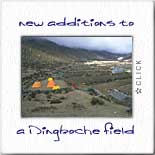
from Namche to Thyangboche
Map
of the Khumbu
The Gear
that got us there
April 1:
Kathmandu
April 2:
Kathmandu
April 3:
Kathmandu
April 4:
Lukla and Phakding
April 5:
Namche
April 6:
Between Namche and Thyangboche
April 7:
Thyangboche
April 8:
Thyangboche
April 9:
Dingboche
April 10:
Dingboche
April 12:
Lobuche
and
Beyond
Trek photos by Peter Potterfield, © 1997 The Zone Network. All rights Reserved.
![]()

 At Dingboche, above 14,400 feet, the dining tent becomes the hearth and
central gathering point for the
expedition. It's colder than the tea house dining rooms, but cozier
and... it's all ours. We have an unusually diverse group: climbers,
scientists, journalists, but it's a congenial — if all male — society. On
these long strange days of acclimatization, when there's no walking to
do, all of us spend a lot of time alone in our tents, dozing, reading,
listening to music, or strolling the nearby hills for exercise.
At Dingboche, above 14,400 feet, the dining tent becomes the hearth and
central gathering point for the
expedition. It's colder than the tea house dining rooms, but cozier
and... it's all ours. We have an unusually diverse group: climbers,
scientists, journalists, but it's a congenial — if all male — society. On
these long strange days of acclimatization, when there's no walking to
do, all of us spend a lot of time alone in our tents, dozing, reading,
listening to music, or strolling the nearby hills for exercise.
| Eleven people had simply vanished, while people who had been roped to the victims remained on the surface unharmed. |
One night the subject turns to premonitions. Eric Simonson describes his attempt on Annapurna, when he awoke one morning at the high camp with a powerful but inexplicable desire — need, really — to get down, get down right now. Heeding the warning, he shouted out, "I'm getting out of here now, anybody want to come?" Three people said yes and lived. The other four were killed when an avalanche swept them away a few hours later.
 But the story that really stayed with me was Greg Wilson's. Quiet, self-contained
and good-natured, Wilson usually does more listening than
talking. At one point, though, he began describing a particular day
during his first year of guiding on Mount Rainier, way back in 1981. It was a normal day: there were 22 clients and guides in the party on the Camp Muir guide route. About halfway up,
maybe more, on summit day, the group took a brief rest on the Ingraham
Glacier. While the clients rested and drank from water bottles, Wilson
unroped to scout the route ahead.
But the story that really stayed with me was Greg Wilson's. Quiet, self-contained
and good-natured, Wilson usually does more listening than
talking. At one point, though, he began describing a particular day
during his first year of guiding on Mount Rainier, way back in 1981. It was a normal day: there were 22 clients and guides in the party on the Camp Muir guide route. About halfway up,
maybe more, on summit day, the group took a brief rest on the Ingraham
Glacier. While the clients rested and drank from water bottles, Wilson
unroped to scout the route ahead.
He said he happened to look up, and saw with disbelief one massive ice block above him rotate slightly, then start to fall. Then the entire ice cliff adjacent to it started coming down, right down on the party of climbers. Wilson watched as an impossible wall of snow and ice debris came crashing down on him.
At first he thought, "Well, this is it," but in just a second he had reversed his thinking: "No way!" He began fighting and furiously swimming to stay on top of the avalanche that quickly engulfed him. When it was over, he was half in, half out of the debris. Digging himself free, he was amazed to find himself virtually uninjured.
 But as he brushed himself off, he kept looking and counting, looking
and counting again. It couldn't be right. One, two, three... no matter
how often he counted,
the number was the same: 11 people still alive, which meant 11 people
dead. The unprecedented ice avalanche had swept half the party into a
huge crevasse, and then entombed them perfectly by filling in the
crevasse with hard-packed debris. Eleven people had simply vanished,
while people who had been roped to the victims remained on the surface
unharmed. The surviving climbers had lost friends,
brothers, fathers in the blink of an eye, yet had not a scratch
themselves. Wilson and Peter Whittaker turned the survivors around and
headed back to Camp Muir.
But as he brushed himself off, he kept looking and counting, looking
and counting again. It couldn't be right. One, two, three... no matter
how often he counted,
the number was the same: 11 people still alive, which meant 11 people
dead. The unprecedented ice avalanche had swept half the party into a
huge crevasse, and then entombed them perfectly by filling in the
crevasse with hard-packed debris. Eleven people had simply vanished,
while people who had been roped to the victims remained on the surface
unharmed. The surviving climbers had lost friends,
brothers, fathers in the blink of an eye, yet had not a scratch
themselves. Wilson and Peter Whittaker turned the survivors around and
headed back to Camp Muir.
Fluky, harsh, and weird, that story says a lot about climbing. Greg was finished, but nobody said anything. It stayed quiet in the dining tent for a long time after he told that one.